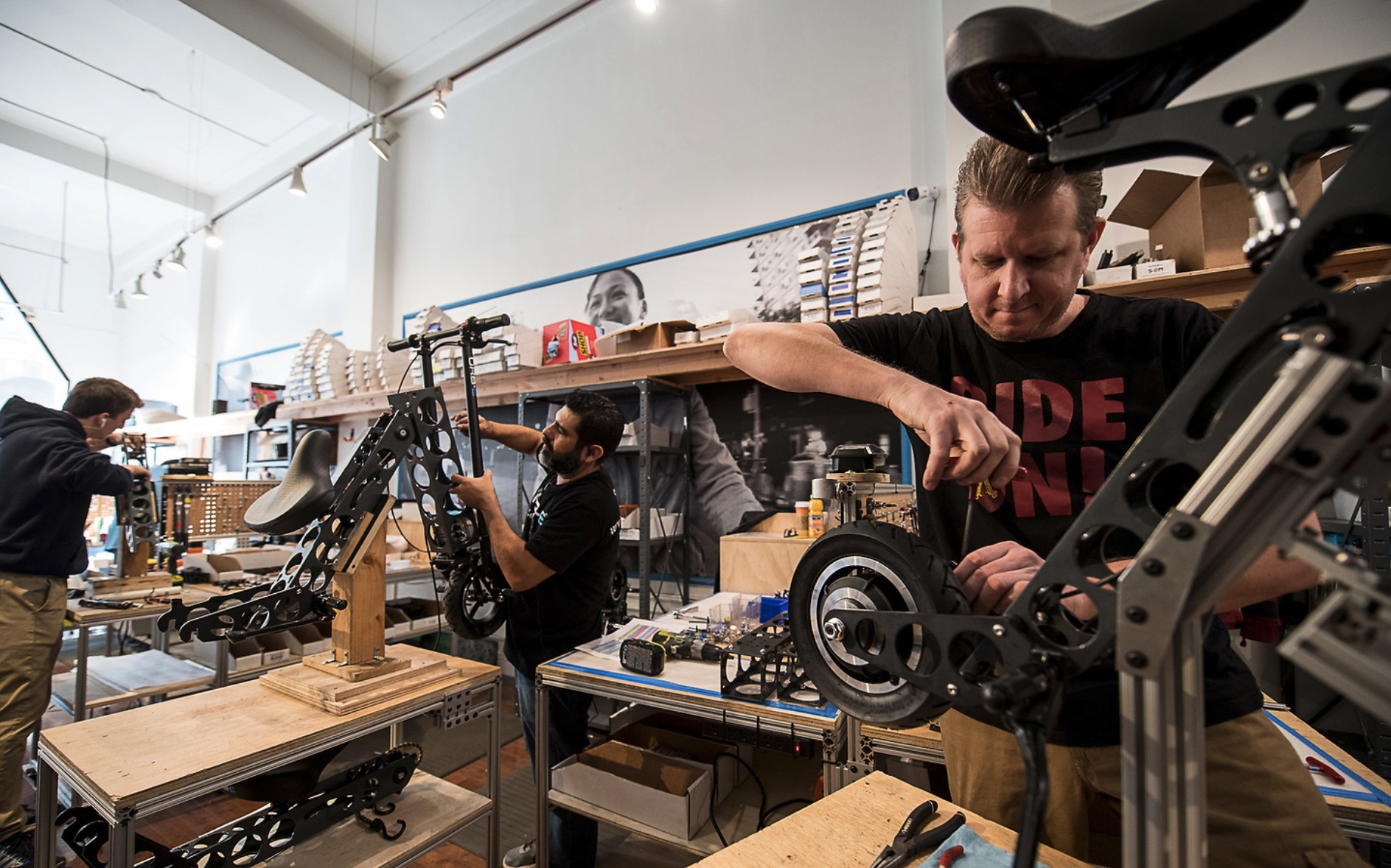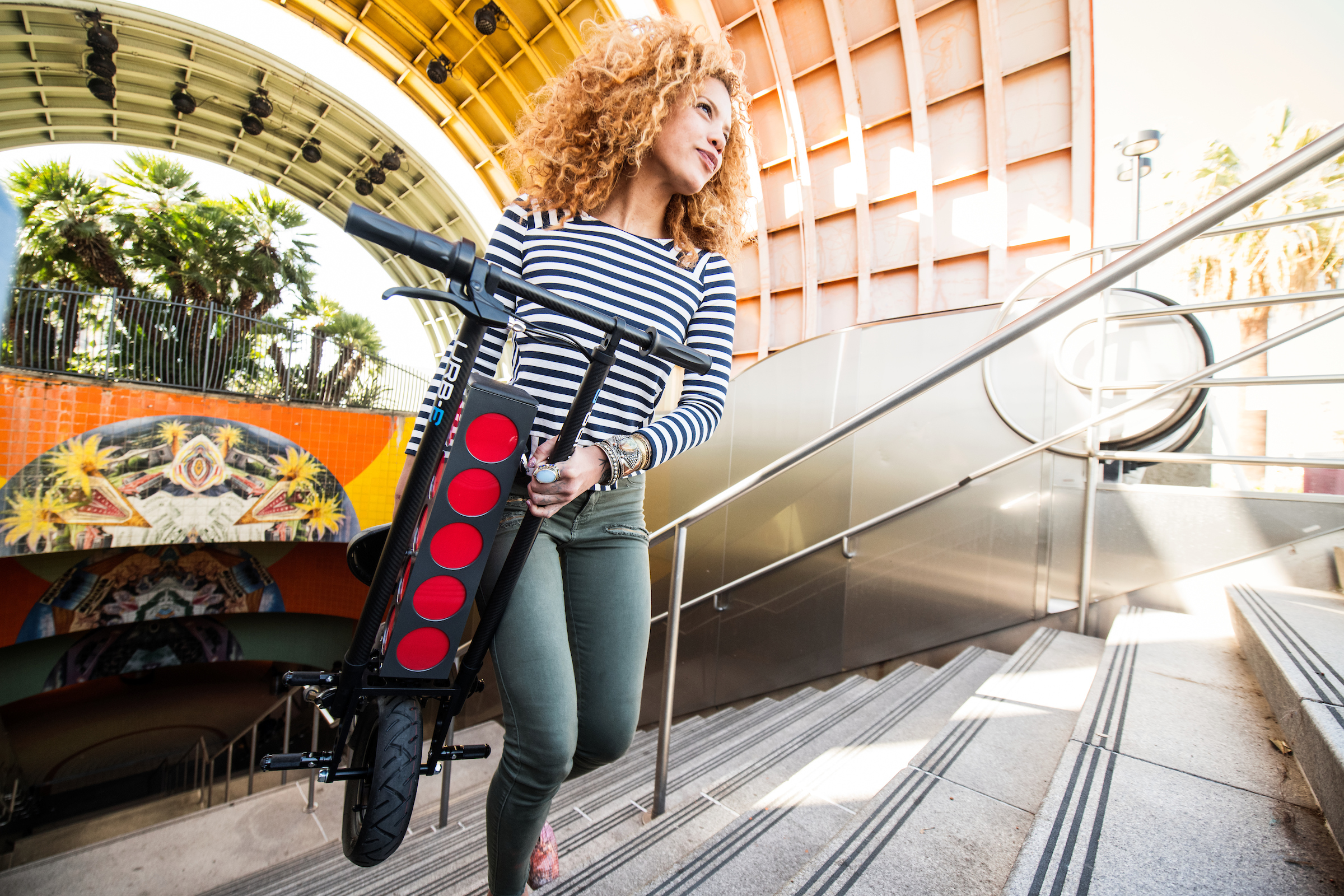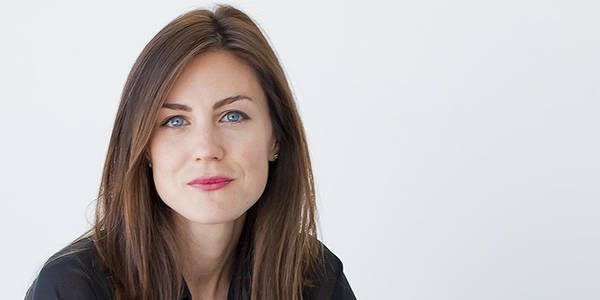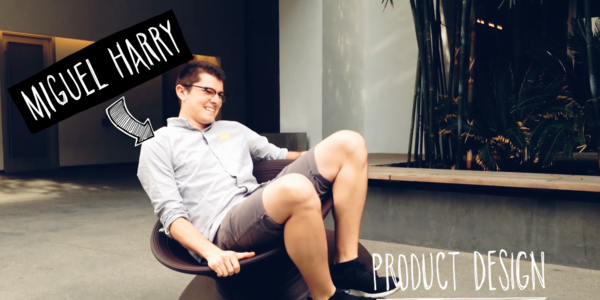
feature / alumni / environmental-design / product-design
May 02, 2018
Writer: Solvej Schou
Images: Courtesy of
Krisztina "Z" Holly
Grant Delgatty
GO BOLD: FOUNDERS OF URB-E AND MAKE IT IN LA DISCUSS NEW ERA OF MANUFACTURING
On a cool spring day, Environmental Design alumnus Grant Delgatty (BS 1995)—cofounder of the Pasadena-based foldable electric scooter company URB-E—saunters into the Los Angeles Cleantech Incubator (LACI) in downtown L.A. to meet up with Krisztina “Z” Holly, founder and chief instigator of the nonprofit organization MAKE IT IN LA, housed at LACI.
L.A. Mayor Eric Garcetti’s office spun off MAKE IT IN LA to promote manufacturing in L.A. County. And stretched across 60,000 square feet of space at the La Kretz Innovation Campus, LACI is a bustling hub for Holly, host of the podcast The Art of Manufacturing.
Delgatty and Holly, an MIT-trained engineer and tech entrepreneur, have some core things in common: They believe in the power of local manufacturing, and they’re speakers at this year’s BOLD, ArtCenter’s symposium for creative entrepreneurs on Saturday, May 12. The daylong event will include keynote speakers such as Harvard Business School Professor and ArtCenter trustee Linda A. Hill, plus conversations, panels and sessions led by experts focused on improving business strategies for artists and designers.


Local manufacturing means local innovation.
Krisztina "Z" Holly
“When it comes to manufacturing, a lot of times people assume they should go overseas,” says Holly—whose enthusiasm emanates around her like an aura—cradling a cup of coffee next to Delgatty, in a spacious break room. “But in many cases it makes more sense to manufacture locally. We're entering a new era of manufacturing that’s creative, tech-enabled and connected.”
At BOLD, Holly will talk to Anita Sengupta, senior vice president of systems engineering at L.A. based tech company Virgin Hyperloop One, and record the conversation live for her podcast. For a panel, Delgatty—a longtime assistant professor in ArtCenter’s Product Design Department—and fellow alum Chris Do (BFA 95 Graphic Design) will discuss paths to building a successful business.
Given the constant news on tariffs, quotas and free trade agreements, the question of whether to make products locally, nationally or internationally is a heated topic. So why go local?
“Local manufacturing means local innovation. It’s about being able to be there when things go wrong, being able to iterate quickly—especially with technology making the process more rapid—and have close relationships with your suppliers,” says Holly. “L.A. is the largest manufacturing center in the country. It’s a unique place with amazing resources and talent.
A MAKE IT IN LA program called Catalyst pairs entrepreneurs who want to produce their products locally with individuals the nonprofit calls “Catalysts,” says Holly, to provide guidance and advice. About 77 percent of the applicants to Catalyst have been women and minority-owned businesses.


I thought, 'There’s something happening here.' So I went to my garage in Pasadena and started tinkering, and designed a rough version of our current URB-E.
Grant Delgatty
Delgatty, who exudes a Southern California cool (and wears snazzy checkered Vans), recalls his own experience. In the late ‘90s, Delgatty worked at footwear brand DVS as the L.A. company’s design director. In the three and a half years he was there, he saw the business grow from zero to $40 million in yearly revenue, he says. Most of the shoes were made in South Korea, and he flew back and forth.
Then, after working as the design director of Vans, Delgatty in 2008 founded the footwear company Urshuz, which allowed customers to customize their shoes by interchanging recyclable soles and uppers using his patented technology. In 2011, he co-founded the open innovation design firm ideapiphany (IDP).
While teaching Mobility Design at ArtCenter in 2012, Delgatty noted that car companies sponsoring projects for the course mentioned the trend of millennials turning to alternate forms of transportation instead of buying cars. The companies wanted students to focus on designing a portable vehicle able to be brought onto trains or buses for that “last mile” to and from stops and homes.
“I thought, ‘There’s something happening here.’ So I went to my garage in Pasadena and started tinkering, and designed a rough version—a real Frankenstein type thing—of our current URB-E,” says Delgatty.
Cofounded by former Porsche, Fisker and Saleen lead engineer Sven Etzelsberger, URB-E went into production in 2015. Pasadena tech entrepreneur Brad King provided funding on the basis that manufacturing would be local.

"When we originally developed the product, we assumed we’d be making it overseas, so we did all our development abroad,” says Delgatty. “Brad said, ‘I want to build it here because I think we should be in control of the process of getting it made.’ In L.A. there’s an unbelievable number of metal fabrication facilities.”
URB-Es weigh only 30 pounds, and zip along at a top speed of 14 miles per hour. The scooters’ aircraft-grade aluminum frame parts are machined locally in Rancho Cucamonga and assembled in the company’s production facility in Pasadena. Their fully removable battery is made in China with “the best” lithium ion cells, says Delgatty.
The company uses a direct-to-consumer model, and ships to more than 40 countries. When a part is made incorrectly, Delgatty’s team can rework it and get it back in a few days. “If we got these parts from overseas and assembled here, we’d be delayed weeks,” says Delgatty.
The idea, too, that parts from abroad are less expensive—saving money—doesn’t take into account the total cost, says Holly, between customs, shipping delays, potential intellectual property theft, and other hidden costs if working with faraway partners.
“From a consumer standpoint, people today want on-demand, same-day delivery,” says Holly. “Forget same day delivery. How about local same-day custom manufacturing? One day, that’s in the future.”
Register for the BOLD Symposium, a daylong event on Saturday, May 12, 2018 designed to celebrate and inspire a growing community of entrepreneurs from ArtCenter and beyond, at artcenter.edu/bold.





